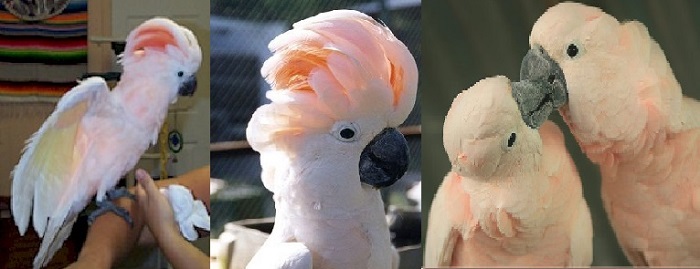Moluccan Cockatoo
genus Cacatua moluccenis

Description: Moluccan Cockatoo
length : around 18-20 inches (can vary)
Sexes: Similar in plumage coloration
The Moluccan Cockatoo has a large salmon colored crest. The large salmon colored crest is directed backwards even when erected. The lower surface of the tail feathers are a combination of pink and yellowish orange. Beak is blackish: Legs dark gray
Origin: The islands of Seram, Haruku and Saparua and parts of Moluccas islands.
Now considered rare and endangered species in the native ranges.
Of course its not for everyone. Most pet owners do not understand what's at stake when purchasing these very loving and demanding birds. These birds remind me of a 2 year old human child that never grows up. Its always give me, I want that, lets see how much noise I can make, etc. Please, if you cannot utterly stop your life and devote it to these creatures please do not even think about it. But for those lucky ones that can give these birds the kind of life they deserve, then you will have a unconditional friend and companion forever. This species is very affectionate to their owners. Talking ability is limited but many have learned to speak quite well. This species without a doubt is the most affectionate bird we have ever seen..
All of our baby Moluccan Cockatoos are incubator hatched and handfed from day one. By doing this we are able to control the environment from day one. Thus resulting in a much more human socialized and healthier baby. This day one control also helps us in keeping our birds healthier, by not letting the parents incubate or brood we eliminate many problems associated with the parents passing on pathogens or the babies picking up many bacteria from the nest boxes. More work for our staff but its worth it. Our quality babies speak for themselves.
All our babies go home with a free complete starter kit, such as food, treat, instructions,etc.
Due to the endangered status we will be holding back any and all babies for future breeding stock. The species at this time needs to be in breeding programs and not pet homes. The species is in grave danger to be totally being wiped out in their native land and also since this species does not breed very well the numbers in captivity are shrinking. The domestic bred babies after becoming adults are many times NOT suitable for breeding, they show little or no interest in breeding and lots of work is needed to establish new bloodlines and stock.














